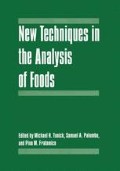Abstract
Electrorheology (ER) is concerned with the effects of electric fields on the flow properties of liquid suspensions that show an increase in apparent viscosity and a greater yield stress during exposure to electric fields. These fluids require polarizable particles suspended in an insulating (non-conducting) oil. The ER phenomenon results from the formation of microstructures of the dispersed solid phase. In other words, the field-induced microstructures attempt to span the fluid gap, causing reduced fluidity.
Access this chapter
Tax calculation will be finalised at checkout
Purchases are for personal use only
Preview
Unable to display preview. Download preview PDF.
References
J.E. Stangroom. 1989. The Bingham plastic model of ER fluids and its implications, in: “Proceedings of the Second International Conference on ER Fluids,” J.D. Carlson, A.F. Sprecher, H. Conrad, eds., Technomic Publishing, Lancaster, PA, pp. 199–206.
R. Pool. 1990. The fluids with a case of split personality, Science 247: 1180.
R.T. Bonnecaze, J.F. Brady. 1992. Yield stresses in electrorheological fluids, J. Rheol. 36: 73.
H. Block, J.P. Kelly. 1988. Electro-rheology, J. Phys. D: Appl. Phys. 21: 1661.
C.F. Zukoski. 1993. Material properties and the electrorheological response, Annu. Rev. Mater. Sci. 23: 45.
Y.F. Deinega, G.V. Vinogradov. 1984. Electric fields in the rheology of disperse systems, Rheol. Acta 23: 636.
T.C. Jordan, M.T. Shaw. 1989. Electrorheology, IEEE Trans. Elec. Insul. 24: 849.
D.L. Klass, T.W. Martinek. 1967. Electroviscous fluids II. electrical properties, J. Appl. Phys. 38: 75.
H. Uejima, 1972. Dielectric mechanism and rheological properties of electro-fluids, Jap. J. Appl. Phys. 11: 319.
D.L. Klass, T.W. Martinek. 1967. Electroviscous fluids I. rheological properties, J. Appl. Phys. 38: 67.
H. Block, J.P. Kelly, A. Qin, T. Watson. 1990. Materials and mechanisms in electrorheology, Langmuir 6: 6.
W. Wong, M.T. Shaw. 1989. The role of water in electrorheological fluids, in: “Proceedings of the Second International Conference on ER Fluids,” J.D. Carlson, A.F. Sprecher, H. Conrad, eds., Technomic Publishing, Lancaster, PA, pp. 191–198.
T.C. Halsey. 1992. Electrorheological fluids, Science 258: 761.
A.P. Gast, C.F. Zukoski. 1989. Electrorheological fluids as colloidal suspensions, Adv. Colloid Interface Sci. 30: 153.
M.T. Shaw. 1993. Structure-property relationships in ER fluids, in: “The Fluids Engineering Conference,” D.A. Siginer, J.H. Kim, and R.A. Bajura, eds., ASME FED-Vol. 164, pp. 43–48.
V.I. Kordonsky, E.V. Korobko, T.G. Lazareva. 1991. Electrorheological polymer-based suspensions, J. Rheol. 35: 1427.
T.A. Vorobeva, I.N. Vlodavets, P.I. Zubov. 1969. The size distribution of oriented aggregates formed in suspensions with the application of an alternating electric field, Kolloid. Zh. 31: 668.
T.B. Jones. 1989. Orientation of particle chains in AC electric fields, in: “Proceedings of the Second International Conference on ER Fluids,” J.D. Carlson, A.F. Sprecher, H. Conrad, eds., Technomic Publishing, Lancaster, PA, pp. 14–26.
I. Yang, A.D. Shine. 1992. Electrorheology of a nematic poly(n-hexyl isocyanate) solution, J. Rheol. 36: 1079.
V.I. Bezruk, A.N. Lazarev, V.A. Malov, and O.G. Usyarov. 1972. Frequency effect of an external electric field on the interaction between dispersed particles in suspensions, K. Zhurnal 34: 321.
J.C. Hill, T.H. Van Steenkiste. 1991. Response times of electrorheolgical fluids, J. Appl. Phys. 70: 1207.
G.B. Thurston, E.B. Gaertner. 1991. Viscoelasticity of electrorheological fluids during oscillatory flow in a rectangular channel, J. Rheol. 35: 1327.
H.T. See, M. Doi. 1992. Shear resistance of electrorheological fluids under time-varying electric fields, J. Rheol. 36: 1143.
R.C. Kanu, M.T. Shaw. 1992. Electrorheological fluids based on PBZT particles with controlled geometry, in: “Proceedings of the Xlth International Congress on Rheology,” pp. 766–768.
D.J. Klingenberg, C.F. Zukoski. 1990. Studies on the steady-shear behavior of electrorheological suspensions, Langmuir 6: 15.
H. Conrad, A.F. Sprecher, Y. Choi, Y. Chen. 1991. The temperature dependence of the electrical properties and strength of electrorheological fluids, J. Rheol. 35: 1393.
R. Tao, J.T. Woestman, N.K. Jaggi. 1989. Electric field induced solidification, Appl. Phys. Lett. 55: 1844.
Jaggi, N.K., J.T. Woestman, R. Tao. 1989. Possible phase transition in electrorheological fluids, in: “Proceedings of the Second International Conference on ER Fluids,” J.D. Carlson, A.F. Sprecher, H. Conrad, eds., Technomic Publishing, Lancaster, PA, pp. 53–62.
Z. Lou, R.D. Ervin, F.E. Filisko. 1993. The influence of viscometer dynamics on the characterization of an electrorheological fluid under sinusoidal electric excitation, J. Rheol. 37: 55.
Y. Otsubo, M. Sekine, and S. Katayama. 1992. Electrorheological properties of silica suspensions, J. Rheol. 36: 479.
W.B. Russel, D.A. Saville,W. R. Schowalter. 1989. “Colloidal Dispersions,” Cambridge University Press, London.
L. Marshall, C.F. Zukoski IV, J.W. Goodwin. 1989. Effects of electric fields on the rheology of non-aqueous concentrated suspensions, J. Chem. Soc. Faraday Trans. 1. 85: 2785.
D.J. Klingenberg, D. Dierking, C.F. Zukoski. 1991. Stress-transfer mechanisms in electrorheological suspensions, J. Chem. Soc. Faraday Trans. 87: 425.
P.M. Adriani, A.P. Gast. 1988. A microscopic model of electrorheology, Phys. Fluids 31: 2757.
C.R. Daubert, J.F. Steffe. 1996. Electrorheological behavior of milk chocolate, J. Texture Stud. 27: 93.
J. Chevalley. 1974. Rheology of chocolate, J. Texture Stud. 22: 177.
H. L. Langhar 1951 “Dimensional Analysis,” John Wiley and Sons, Inc., New York.
Author information
Authors and Affiliations
Editor information
Editors and Affiliations
Rights and permissions
Copyright information
© 1998 Springer Science+Business Media New York
About this chapter
Cite this chapter
Daubert, C.R., Steffe, J.F. (1998). Dimensional Analysis of the Electrorheological Behavior of Milk Chocolate. In: Tunick, M.H., Palumbo, S.A., Fratamico, P.M. (eds) New Techniques in the Analysis of Foods. Springer, Boston, MA. https://doi.org/10.1007/978-1-4757-5995-2_3
Download citation
DOI: https://doi.org/10.1007/978-1-4757-5995-2_3
Publisher Name: Springer, Boston, MA
Print ISBN: 978-1-4419-3307-2
Online ISBN: 978-1-4757-5995-2
eBook Packages: Springer Book Archive

